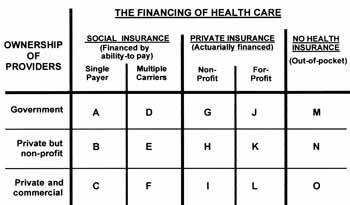Cell A represents pure “socialized medicine” such as the V.A. health system. In that system government performs all of the basic functions listed in the article.
Cells A to F represent “social insurance” systems. In these, government performs the financing and risk-pooling functions, and the insured’s contribution to that risk pool is based on her or his ability to pay. Health care under social insurance can be purchased under two distinct arrangements. One of these is the single-payer approach (cells A, B, C), such as Medicare, the provincial Canadian health plans or Taiwan’s single-payer national health-insurance system. The alternative model is a multiple-payer system (cells D, E, F), such as the private Medicare Advantage plans or Medicaid managed-care plans in the United States or the Statutory Health Insurance system in Germany, under which over 200 independent, nonprofit sickness funds compete for enrollees mainly on the basis of the quality of their services. Under either arrangement, however, the delivery side can embrace all forms of ownership and control. Government manages only the financing and risk-pooling functions and sometimes the purchasing function as well.
In health systems that rely mainly on private not-for-profit insurers (cells G, H, I) or for-profit insurers (cells J, K, L) the individual’s contribution to risk pools typically is not based on ability to pay, but is either a per-capita levy, if insurance premiums are community rated, or is a so-called “actuarially fair” premium based on the individual’s health status and set to come close to the insurer’s actuarially expected outlays for that individual’s health care in the coming period. In the eyes of Europeans and Canadians, the per-capita basis and even more the actuarially fair approach to setting premiums violates the principle of social solidarity. Many Americans, however, seem to find them ethically acceptable.
Finally, the complete or partial lack of insurance in cells M, N and O approximates a genuinely free market in health care, because it avoids the “moral hazard” inherent in health insurance. “Moral hazard” refers to the potential for overuse of health care, because at the point of using health care an insured person pays much less than the true full cost of producing that care. While some thinkers may deem this arrangement an ideal, few modern societies embrace it. First, it fails to harvest the benefits from protection against the financial inroads of illness. Second, it violates widely shared principles of fairness.








